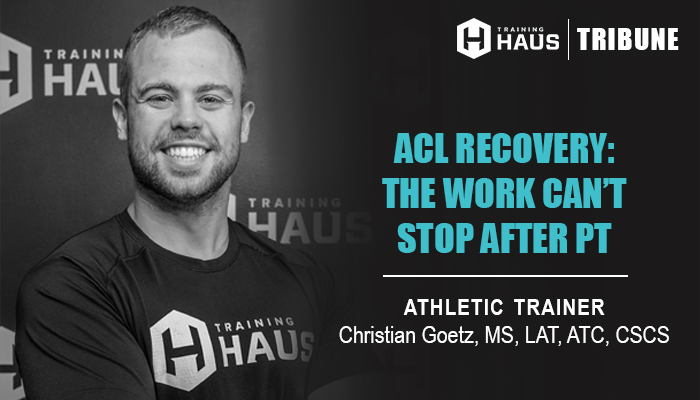
ACL Recovery: The Work Can’t Stop After PT
It is imperative that athletes are safe and return to a high level of competition. This requires both clinicians and patients to fully commit to the return to sport process.
Quadriceps Deficits Following ACL Surgery
One of the primary goals after ACL surgery is to help restore the quadriceps back to being fully functional. Believe it or not, this is the focus at both the early phases and end phases of ACL rehabilitation.
Before an athlete returns to sport, it’s important to ensure that the quadriceps muscle on the surgical knee is strong enough to support the newly reconstructed ACL for high intensity movements that require rapid force development. The research is very clear that quad weakness can persist for some time following surgery and that quad strength is a key indicator of successful return to sport. This is why at Training HAUS/Twin Cities Orthopedics, we have our patients complete a TRAC-ACL test (a comprehensive, 60-minute testing session in our revolutionary Sports Science Lab) at 3, 6, and 9 months post-op.
Strength Training After ACL Surgery and Rate of Force Development
Once patients are roughly 3 months post-op, they typically begin resistance training that specifically targets the quadriceps. Resistance training has been shown to significantly improve rate of force development (RFD) and is one of the most important tools we can use to incorporate RFD into our rehab process.
Resistance training can enhance specific characteristics of skeletal muscle when programmed appropriately. The goal is to grow the size of the quadriceps muscle as well as the rate at which that muscle can produce/generate force. Resistance training increases the size of and number of structural properties within the muscle that generates tension.
Let’s think of quadriceps size as the wheels on a car, and the nervous system as the engine. After an ACL procedure, the surgical knee is deflated and has an engine that hasn’t been revved up for the last 3 months. A race car driver would want a vehicle that has a strong set of tires and an engine that can get them from 0-60mph in just a matter of seconds.
It is important that the quadriceps muscle has a strong foundation/base before we begin to incorporate true strength, power, speed, and ballistic movement. This is why the mid-phase of rehabilitation is critical for patients. Rate of force development is highly influenced by the physical characteristics of skeletal muscle and the nervous system. This is why a patient wants a big strong quad and a nervous system that is primed for sport-specific movement.
Rate of force and torque development is defined as the ability of the neuromuscular system to produce a high rate of rise in muscle force, per unit of time during the initial phase following contraction onset. Think of this as the change in force over the change in time.
Training Rate of Force Development (RFD)
There are two ways to train Rate of Force Development:
- High intensity strength training: This does not necessarily improve how fast we can produce force, rather how much force we can produce. Strength training will help us reach higher levels of force, resulting in us generating a higher level of force within a faster amount of time than our previous baseline.
- Plyometric/Ballistic Movement: This does not increase our maximal force output. Instead, it can help reach the same level of force but in a faster amount of time. Quick ballistic movements such as jumping or any exercise selection that requires the rapid onset of force in a short amount of time can help make this adaptation.
What Next?
Our ACE Strength and ACE Sport program at Training HAUS and Twin Cities Orthopedics serves to address the strength deficits patients experience following an ACL procedure. ACE Strength puts air in a patient’s tires, while our ACE Sport program primes a patient’s engine so that their car can go from 0-60mph in a matter of seconds. RFD is a strength attribute that our team targets in our ACE programming to ensure athletes return to their sport at a higher level than pre-injury.
If you are an athlete recovering from an ACL procedure, please talk to your physical therapist and/or athletic trainer about our ACE program.
More information: TrainingHAUS.com/ace/
Sources
- Maffiuletti, N.A., Aagaard P., Blazevich, A.J., Folland, J., Tillin, N.T., Duchateau, J. (2015). Rate of Force Development: Physiological and Methodological Considerations. European Journal of Applied Physiology, 116: 1091-1116.
- Lum D, Haff GG, Barbosa TM. The Relationship between Isometric Force-Time Characteristics and Dynamic Performance: A Systematic Review. Sports. 2020; 8(5):63.
- Johnson, K. A., Palmieri-Smith, M. R., Lepley, K. L. (2018). Contribution of Neuromuscular Factors to Quadriceps Asymmetry After Anterior Cruciate Ligament Reconstruction. Journal of Athletic Training, 53(4): 347-354.
- Maestroni, L., Read, P., Bishop, C., Turner, A. (2020). Strength and power training in rehabilitation: underpinning principles and practical strategies to return athletes to high performance. Sports Medicine, 50 (2). 239-252.

